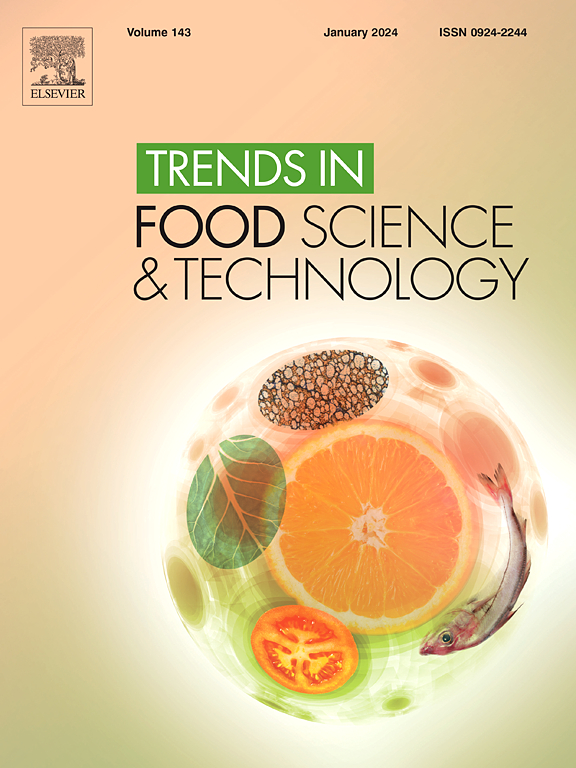Research progress of biopolymer-based food packaging films/coatings functionalized with edible photosensitizers
IF 15.1
1区 农林科学
Q1 FOOD SCIENCE & TECHNOLOGY
引用次数: 0
Abstract
Background
Packaging is essential for protecting food from environmental factors and contamination. However, the overuse and improper disposal of petroleum-based plastics have caused serious environmental pollution and health risks. To address these issues, biopolymer-based films and coatings with antimicrobial properties have attracted attention in food science, aiming to reduce waste and improve food safety by inhibiting spoilage microorganisms. Traditionally, antimicrobial agents are directly added to films. However, the use of photodynamic inactivation (PDI) provides a promising emerging approach for creating highly effective antimicrobial food packaging films.
Scope and approach
This work focuses on the progress of biopolymer-based food packaging films (BFPF) functionalized with edible photosensitizers (PSs), including curcumin, riboflavin, and chlorophyll. First, the antimicrobial mechanism of PDI and the characteristics of common edible PSs are briefly introduced, and the effects of different edible PSs on the comprehensive properties of BFPF, including mechanical properties, barrier properties, antioxidant properties, and antimicrobial properties, are discussed in detail. Finally, this work also systematically summarizes the application progress of edible coatings functionalized with edible PSs in food preservation.
Key findings and conclusions
This work found that edible PSs can not only provide PDI antimicrobial activity for BFPF, but also serve as multifunctional additives, such as antioxidants and crosslinkers, to improve the comprehensive properties of composite films. In addition, food packaging films with multi-mode synergistic antimicrobial properties can be developed through the modification of edible PSs.
食用光敏剂功能化生物聚合物基食品包装膜/涂料的研究进展
背景包装对于保护食品免受环境因素和污染至关重要。然而,石油基塑料的过度使用和处置不当造成了严重的环境污染和健康风险。为了解决这些问题,具有抗菌性能的生物聚合物薄膜和涂层引起了食品科学的关注,旨在通过抑制腐败微生物来减少浪费,提高食品安全。传统上,抗菌剂直接添加到薄膜中。然而,使用光动力灭活(PDI)为创建高效抗菌食品包装薄膜提供了一个有前途的新方法。范围和方法本工作主要研究了用可食用光敏剂(ps)功能化的生物聚合物基食品包装膜(BFPF)的进展,包括姜黄素、核黄素和叶绿素。首先,简要介绍了PDI的抗菌机理和常用食用ps的特点,并详细讨论了不同食用ps对BFPF综合性能的影响,包括力学性能、阻隔性能、抗氧化性能和抗菌性能。最后,系统总结了可食用ps功能化涂料在食品保鲜中的应用进展。本研究发现,食用ps不仅可以为BFPF提供PDI抗菌活性,还可以作为抗氧化剂和交联剂等多功能添加剂,改善复合膜的综合性能。此外,通过对可食用ps进行改性,可以开发出具有多模式协同抗菌性能的食品包装膜。
本文章由计算机程序翻译,如有差异,请以英文原文为准。
求助全文
约1分钟内获得全文
求助全文
来源期刊

Trends in Food Science & Technology
工程技术-食品科技
CiteScore
32.50
自引率
2.60%
发文量
322
审稿时长
37 days
期刊介绍:
Trends in Food Science & Technology is a prestigious international journal that specializes in peer-reviewed articles covering the latest advancements in technology, food science, and human nutrition. It serves as a bridge between specialized primary journals and general trade magazines, providing readable and scientifically rigorous reviews and commentaries on current research developments and their potential applications in the food industry.
Unlike traditional journals, Trends in Food Science & Technology does not publish original research papers. Instead, it focuses on critical and comprehensive reviews to offer valuable insights for professionals in the field. By bringing together cutting-edge research and industry applications, this journal plays a vital role in disseminating knowledge and facilitating advancements in the food science and technology sector.
 求助内容:
求助内容: 应助结果提醒方式:
应助结果提醒方式:


